Business Plan: Buster's Retail Store Expansion and Operations Analysis
VerifiedAdded on 2021/02/20
|11
|3119
|309
Report
AI Summary
This report details a business plan for Buster's, a small retail store seeking to expand from a single location to a two-store operation. The plan includes an introduction outlining the business and its aspirations, followed by a description of the organization, including the owner's qualifications, legal structure, management team, employees, and vendors. Financial projections, such as cash flow, payback point, and anticipated ROI, are presented. The marketing and sales section covers strategy, requirements, and competition. Operational aspects, including location and procedures, are also discussed. The report addresses legal issues, including intellectual property, commercial law, and liabilities, and concludes with an assessment of major challenges. The plan emphasizes content marketing, diversification of products, and affordable pricing to attract customers in the new location.
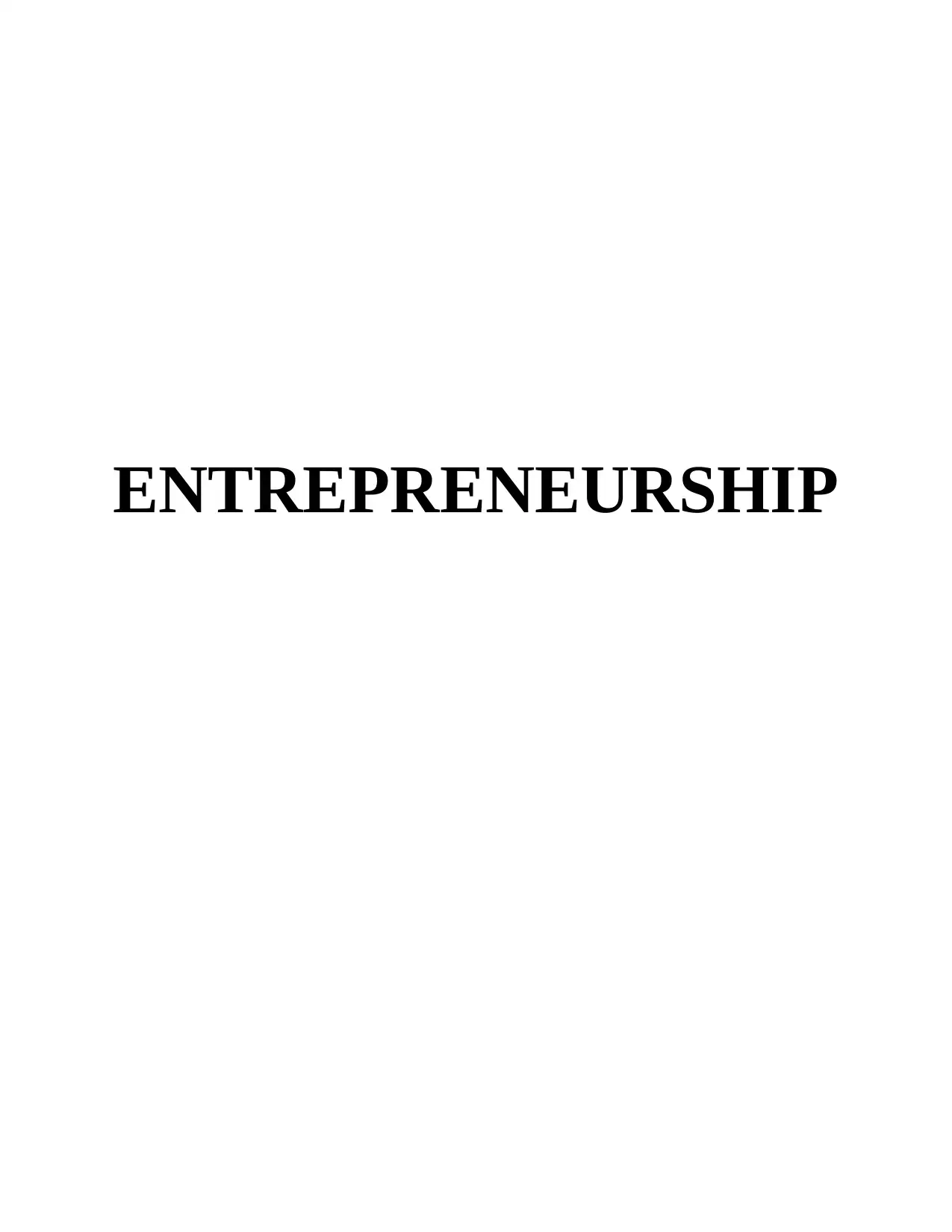
ENTREPRENEURSHIP
Paraphrase This Document
Need a fresh take? Get an instant paraphrase of this document with our AI Paraphraser
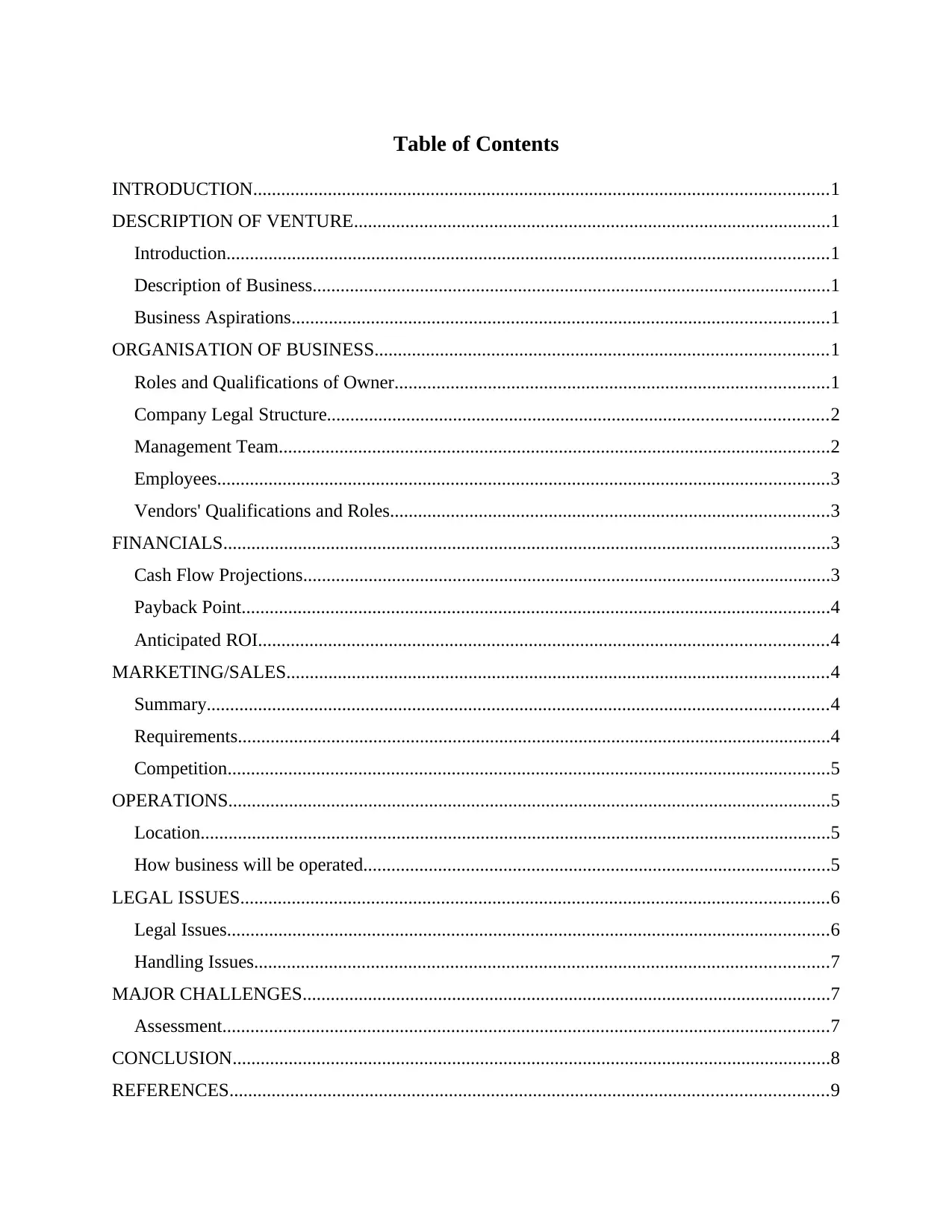
Table of Contents
INTRODUCTION...........................................................................................................................1
DESCRIPTION OF VENTURE......................................................................................................1
Introduction.................................................................................................................................1
Description of Business...............................................................................................................1
Business Aspirations...................................................................................................................1
ORGANISATION OF BUSINESS.................................................................................................1
Roles and Qualifications of Owner.............................................................................................1
Company Legal Structure...........................................................................................................2
Management Team......................................................................................................................2
Employees...................................................................................................................................3
Vendors' Qualifications and Roles..............................................................................................3
FINANCIALS..................................................................................................................................3
Cash Flow Projections.................................................................................................................3
Payback Point..............................................................................................................................4
Anticipated ROI..........................................................................................................................4
MARKETING/SALES....................................................................................................................4
Summary.....................................................................................................................................4
Requirements...............................................................................................................................4
Competition.................................................................................................................................5
OPERATIONS.................................................................................................................................5
Location.......................................................................................................................................5
How business will be operated....................................................................................................5
LEGAL ISSUES..............................................................................................................................6
Legal Issues.................................................................................................................................6
Handling Issues...........................................................................................................................7
MAJOR CHALLENGES.................................................................................................................7
Assessment..................................................................................................................................7
CONCLUSION................................................................................................................................8
REFERENCES................................................................................................................................9
INTRODUCTION...........................................................................................................................1
DESCRIPTION OF VENTURE......................................................................................................1
Introduction.................................................................................................................................1
Description of Business...............................................................................................................1
Business Aspirations...................................................................................................................1
ORGANISATION OF BUSINESS.................................................................................................1
Roles and Qualifications of Owner.............................................................................................1
Company Legal Structure...........................................................................................................2
Management Team......................................................................................................................2
Employees...................................................................................................................................3
Vendors' Qualifications and Roles..............................................................................................3
FINANCIALS..................................................................................................................................3
Cash Flow Projections.................................................................................................................3
Payback Point..............................................................................................................................4
Anticipated ROI..........................................................................................................................4
MARKETING/SALES....................................................................................................................4
Summary.....................................................................................................................................4
Requirements...............................................................................................................................4
Competition.................................................................................................................................5
OPERATIONS.................................................................................................................................5
Location.......................................................................................................................................5
How business will be operated....................................................................................................5
LEGAL ISSUES..............................................................................................................................6
Legal Issues.................................................................................................................................6
Handling Issues...........................................................................................................................7
MAJOR CHALLENGES.................................................................................................................7
Assessment..................................................................................................................................7
CONCLUSION................................................................................................................................8
REFERENCES................................................................................................................................9
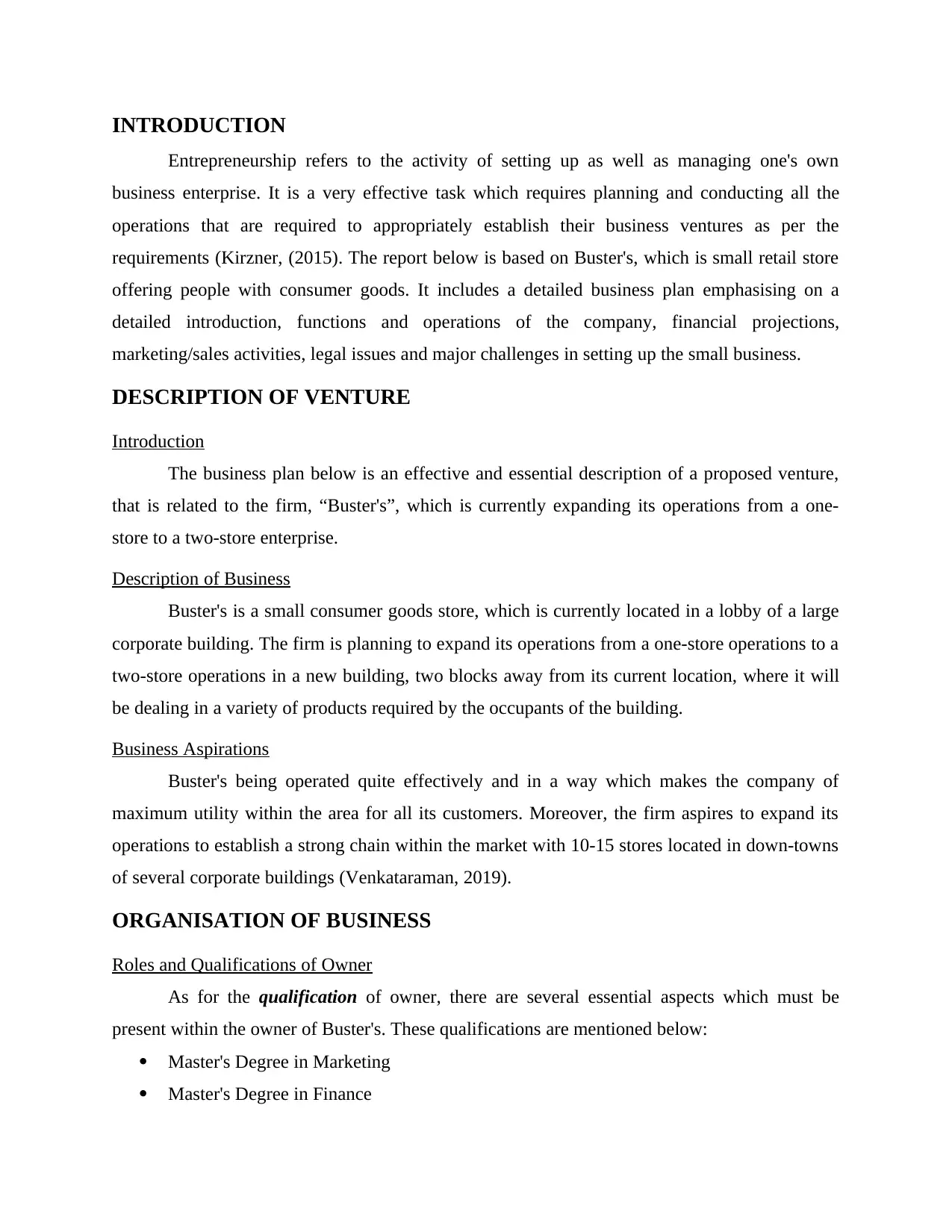
INTRODUCTION
Entrepreneurship refers to the activity of setting up as well as managing one's own
business enterprise. It is a very effective task which requires planning and conducting all the
operations that are required to appropriately establish their business ventures as per the
requirements (Kirzner, (2015). The report below is based on Buster's, which is small retail store
offering people with consumer goods. It includes a detailed business plan emphasising on a
detailed introduction, functions and operations of the company, financial projections,
marketing/sales activities, legal issues and major challenges in setting up the small business.
DESCRIPTION OF VENTURE
Introduction
The business plan below is an effective and essential description of a proposed venture,
that is related to the firm, “Buster's”, which is currently expanding its operations from a one-
store to a two-store enterprise.
Description of Business
Buster's is a small consumer goods store, which is currently located in a lobby of a large
corporate building. The firm is planning to expand its operations from a one-store operations to a
two-store operations in a new building, two blocks away from its current location, where it will
be dealing in a variety of products required by the occupants of the building.
Business Aspirations
Buster's being operated quite effectively and in a way which makes the company of
maximum utility within the area for all its customers. Moreover, the firm aspires to expand its
operations to establish a strong chain within the market with 10-15 stores located in down-towns
of several corporate buildings (Venkataraman, 2019).
ORGANISATION OF BUSINESS
Roles and Qualifications of Owner
As for the qualification of owner, there are several essential aspects which must be
present within the owner of Buster's. These qualifications are mentioned below:
Master's Degree in Marketing
Master's Degree in Finance
Entrepreneurship refers to the activity of setting up as well as managing one's own
business enterprise. It is a very effective task which requires planning and conducting all the
operations that are required to appropriately establish their business ventures as per the
requirements (Kirzner, (2015). The report below is based on Buster's, which is small retail store
offering people with consumer goods. It includes a detailed business plan emphasising on a
detailed introduction, functions and operations of the company, financial projections,
marketing/sales activities, legal issues and major challenges in setting up the small business.
DESCRIPTION OF VENTURE
Introduction
The business plan below is an effective and essential description of a proposed venture,
that is related to the firm, “Buster's”, which is currently expanding its operations from a one-
store to a two-store enterprise.
Description of Business
Buster's is a small consumer goods store, which is currently located in a lobby of a large
corporate building. The firm is planning to expand its operations from a one-store operations to a
two-store operations in a new building, two blocks away from its current location, where it will
be dealing in a variety of products required by the occupants of the building.
Business Aspirations
Buster's being operated quite effectively and in a way which makes the company of
maximum utility within the area for all its customers. Moreover, the firm aspires to expand its
operations to establish a strong chain within the market with 10-15 stores located in down-towns
of several corporate buildings (Venkataraman, 2019).
ORGANISATION OF BUSINESS
Roles and Qualifications of Owner
As for the qualification of owner, there are several essential aspects which must be
present within the owner of Buster's. These qualifications are mentioned below:
Master's Degree in Marketing
Master's Degree in Finance
⊘ This is a preview!⊘
Do you want full access?
Subscribe today to unlock all pages.

Trusted by 1+ million students worldwide
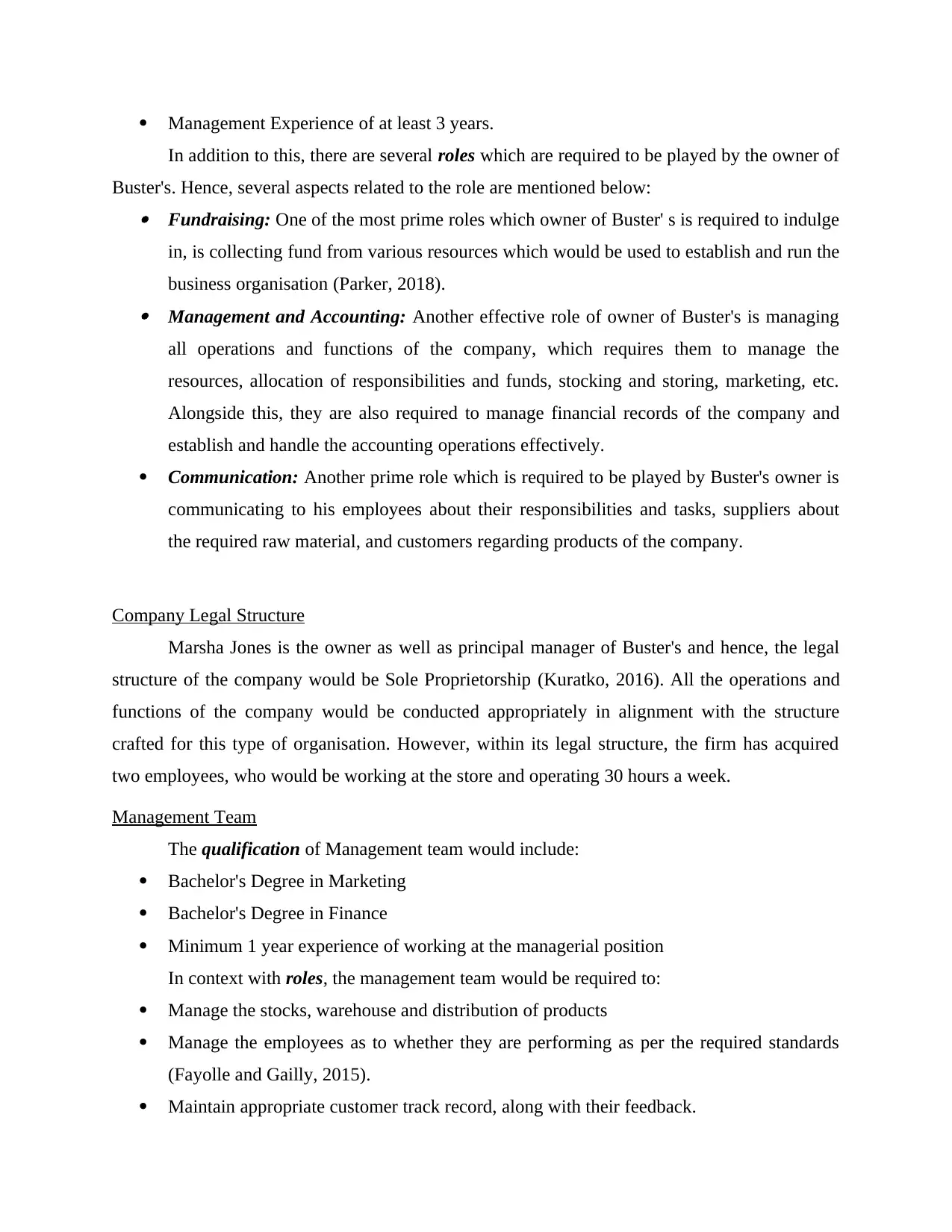
Management Experience of at least 3 years.
In addition to this, there are several roles which are required to be played by the owner of
Buster's. Hence, several aspects related to the role are mentioned below: Fundraising: One of the most prime roles which owner of Buster' s is required to indulge
in, is collecting fund from various resources which would be used to establish and run the
business organisation (Parker, 2018). Management and Accounting: Another effective role of owner of Buster's is managing
all operations and functions of the company, which requires them to manage the
resources, allocation of responsibilities and funds, stocking and storing, marketing, etc.
Alongside this, they are also required to manage financial records of the company and
establish and handle the accounting operations effectively.
Communication: Another prime role which is required to be played by Buster's owner is
communicating to his employees about their responsibilities and tasks, suppliers about
the required raw material, and customers regarding products of the company.
Company Legal Structure
Marsha Jones is the owner as well as principal manager of Buster's and hence, the legal
structure of the company would be Sole Proprietorship (Kuratko, 2016). All the operations and
functions of the company would be conducted appropriately in alignment with the structure
crafted for this type of organisation. However, within its legal structure, the firm has acquired
two employees, who would be working at the store and operating 30 hours a week.
Management Team
The qualification of Management team would include:
Bachelor's Degree in Marketing
Bachelor's Degree in Finance
Minimum 1 year experience of working at the managerial position
In context with roles, the management team would be required to:
Manage the stocks, warehouse and distribution of products
Manage the employees as to whether they are performing as per the required standards
(Fayolle and Gailly, 2015).
Maintain appropriate customer track record, along with their feedback.
In addition to this, there are several roles which are required to be played by the owner of
Buster's. Hence, several aspects related to the role are mentioned below: Fundraising: One of the most prime roles which owner of Buster' s is required to indulge
in, is collecting fund from various resources which would be used to establish and run the
business organisation (Parker, 2018). Management and Accounting: Another effective role of owner of Buster's is managing
all operations and functions of the company, which requires them to manage the
resources, allocation of responsibilities and funds, stocking and storing, marketing, etc.
Alongside this, they are also required to manage financial records of the company and
establish and handle the accounting operations effectively.
Communication: Another prime role which is required to be played by Buster's owner is
communicating to his employees about their responsibilities and tasks, suppliers about
the required raw material, and customers regarding products of the company.
Company Legal Structure
Marsha Jones is the owner as well as principal manager of Buster's and hence, the legal
structure of the company would be Sole Proprietorship (Kuratko, 2016). All the operations and
functions of the company would be conducted appropriately in alignment with the structure
crafted for this type of organisation. However, within its legal structure, the firm has acquired
two employees, who would be working at the store and operating 30 hours a week.
Management Team
The qualification of Management team would include:
Bachelor's Degree in Marketing
Bachelor's Degree in Finance
Minimum 1 year experience of working at the managerial position
In context with roles, the management team would be required to:
Manage the stocks, warehouse and distribution of products
Manage the employees as to whether they are performing as per the required standards
(Fayolle and Gailly, 2015).
Maintain appropriate customer track record, along with their feedback.
Paraphrase This Document
Need a fresh take? Get an instant paraphrase of this document with our AI Paraphraser
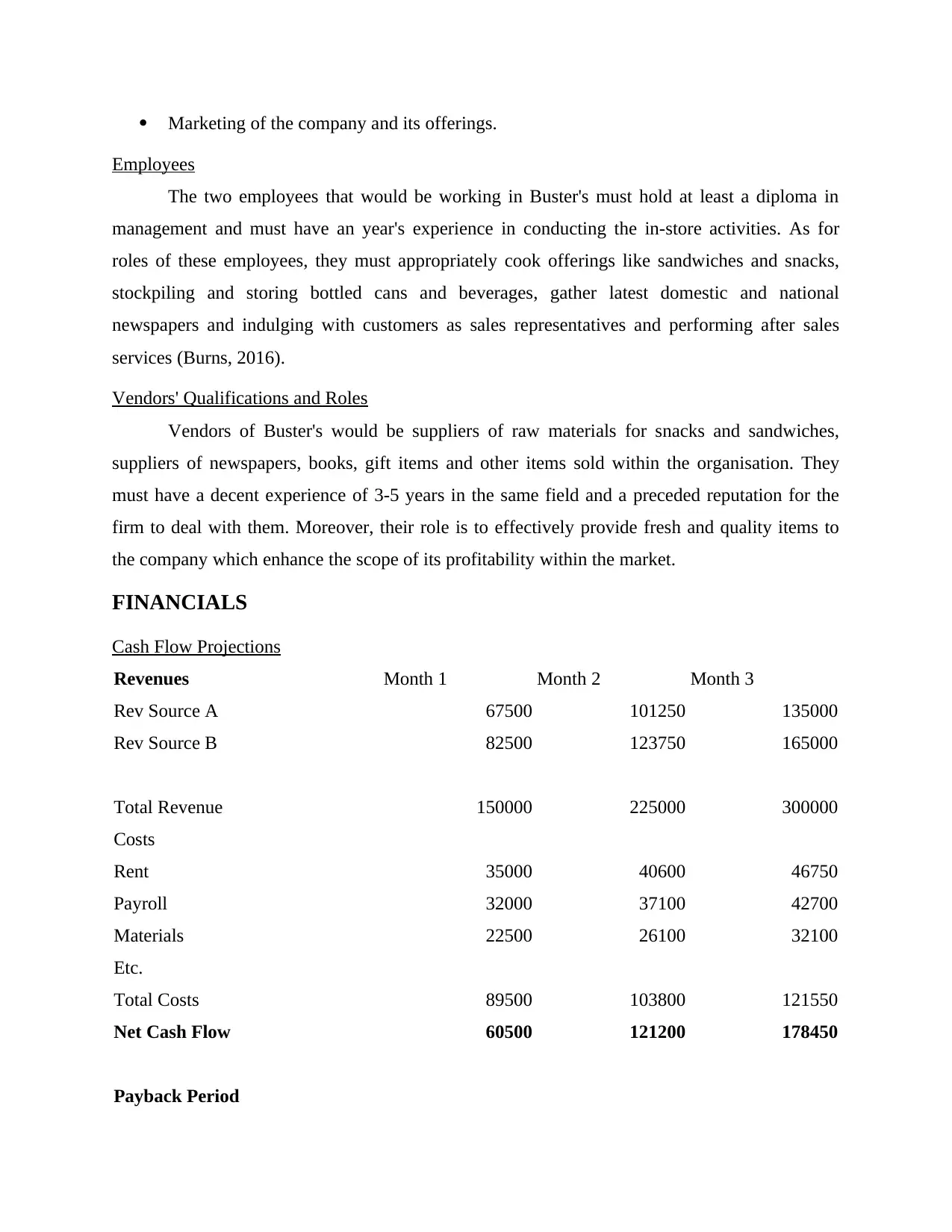
Marketing of the company and its offerings.
Employees
The two employees that would be working in Buster's must hold at least a diploma in
management and must have an year's experience in conducting the in-store activities. As for
roles of these employees, they must appropriately cook offerings like sandwiches and snacks,
stockpiling and storing bottled cans and beverages, gather latest domestic and national
newspapers and indulging with customers as sales representatives and performing after sales
services (Burns, 2016).
Vendors' Qualifications and Roles
Vendors of Buster's would be suppliers of raw materials for snacks and sandwiches,
suppliers of newspapers, books, gift items and other items sold within the organisation. They
must have a decent experience of 3-5 years in the same field and a preceded reputation for the
firm to deal with them. Moreover, their role is to effectively provide fresh and quality items to
the company which enhance the scope of its profitability within the market.
FINANCIALS
Cash Flow Projections
Revenues Month 1 Month 2 Month 3
Rev Source A 67500 101250 135000
Rev Source B 82500 123750 165000
Total Revenue 150000 225000 300000
Costs
Rent 35000 40600 46750
Payroll 32000 37100 42700
Materials 22500 26100 32100
Etc.
Total Costs 89500 103800 121550
Net Cash Flow 60500 121200 178450
Payback Period
Employees
The two employees that would be working in Buster's must hold at least a diploma in
management and must have an year's experience in conducting the in-store activities. As for
roles of these employees, they must appropriately cook offerings like sandwiches and snacks,
stockpiling and storing bottled cans and beverages, gather latest domestic and national
newspapers and indulging with customers as sales representatives and performing after sales
services (Burns, 2016).
Vendors' Qualifications and Roles
Vendors of Buster's would be suppliers of raw materials for snacks and sandwiches,
suppliers of newspapers, books, gift items and other items sold within the organisation. They
must have a decent experience of 3-5 years in the same field and a preceded reputation for the
firm to deal with them. Moreover, their role is to effectively provide fresh and quality items to
the company which enhance the scope of its profitability within the market.
FINANCIALS
Cash Flow Projections
Revenues Month 1 Month 2 Month 3
Rev Source A 67500 101250 135000
Rev Source B 82500 123750 165000
Total Revenue 150000 225000 300000
Costs
Rent 35000 40600 46750
Payroll 32000 37100 42700
Materials 22500 26100 32100
Etc.
Total Costs 89500 103800 121550
Net Cash Flow 60500 121200 178450
Payback Period
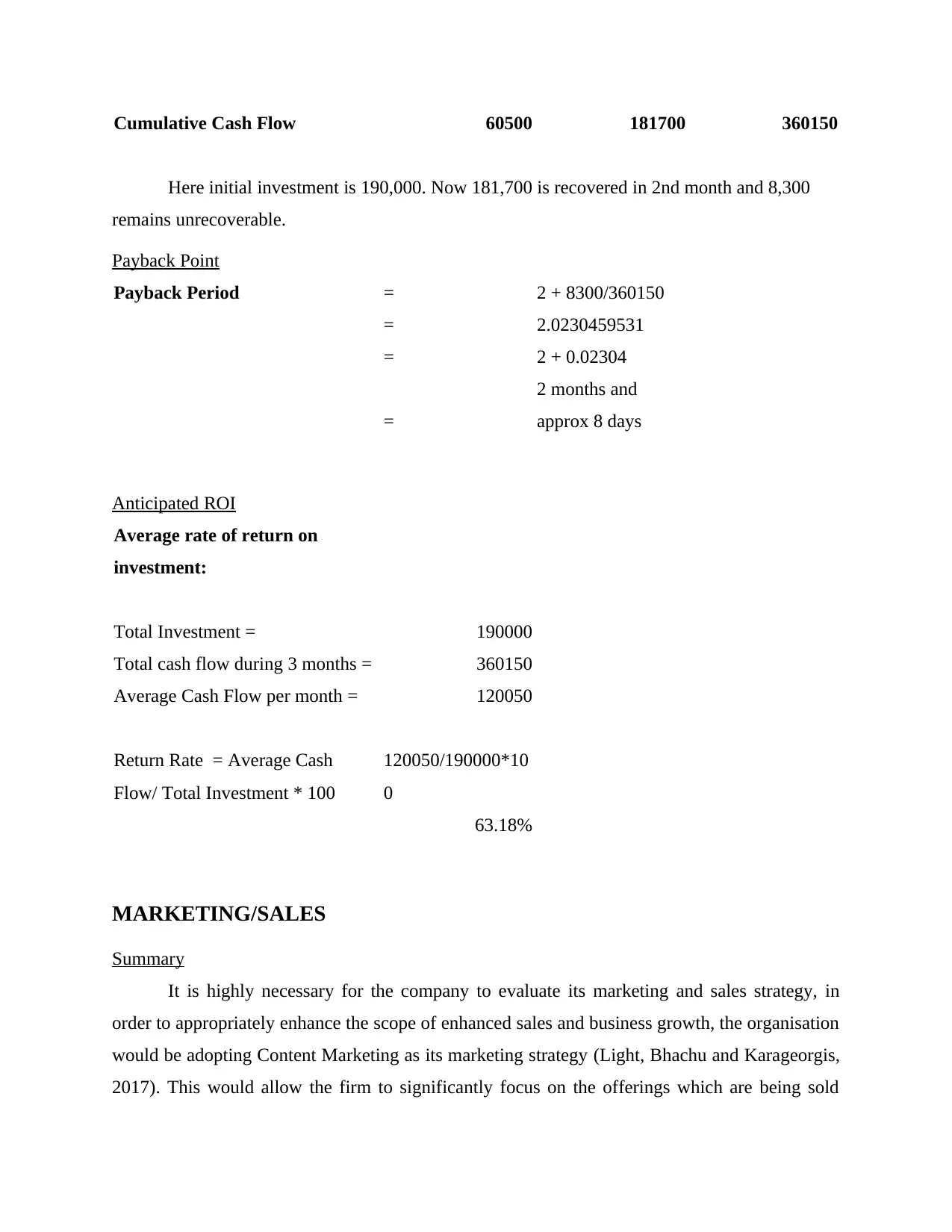
Cumulative Cash Flow 60500 181700 360150
Here initial investment is 190,000. Now 181,700 is recovered in 2nd month and 8,300
remains unrecoverable.
Payback Point
Payback Period = 2 + 8300/360150
= 2.0230459531
= 2 + 0.02304
=
2 months and
approx 8 days
Anticipated ROI
Average rate of return on
investment:
Total Investment = 190000
Total cash flow during 3 months = 360150
Average Cash Flow per month = 120050
Return Rate = Average Cash
Flow/ Total Investment * 100
120050/190000*10
0
63.18%
MARKETING/SALES
Summary
It is highly necessary for the company to evaluate its marketing and sales strategy, in
order to appropriately enhance the scope of enhanced sales and business growth, the organisation
would be adopting Content Marketing as its marketing strategy (Light, Bhachu and Karageorgis,
2017). This would allow the firm to significantly focus on the offerings which are being sold
Here initial investment is 190,000. Now 181,700 is recovered in 2nd month and 8,300
remains unrecoverable.
Payback Point
Payback Period = 2 + 8300/360150
= 2.0230459531
= 2 + 0.02304
=
2 months and
approx 8 days
Anticipated ROI
Average rate of return on
investment:
Total Investment = 190000
Total cash flow during 3 months = 360150
Average Cash Flow per month = 120050
Return Rate = Average Cash
Flow/ Total Investment * 100
120050/190000*10
0
63.18%
MARKETING/SALES
Summary
It is highly necessary for the company to evaluate its marketing and sales strategy, in
order to appropriately enhance the scope of enhanced sales and business growth, the organisation
would be adopting Content Marketing as its marketing strategy (Light, Bhachu and Karageorgis,
2017). This would allow the firm to significantly focus on the offerings which are being sold
⊘ This is a preview!⊘
Do you want full access?
Subscribe today to unlock all pages.

Trusted by 1+ million students worldwide
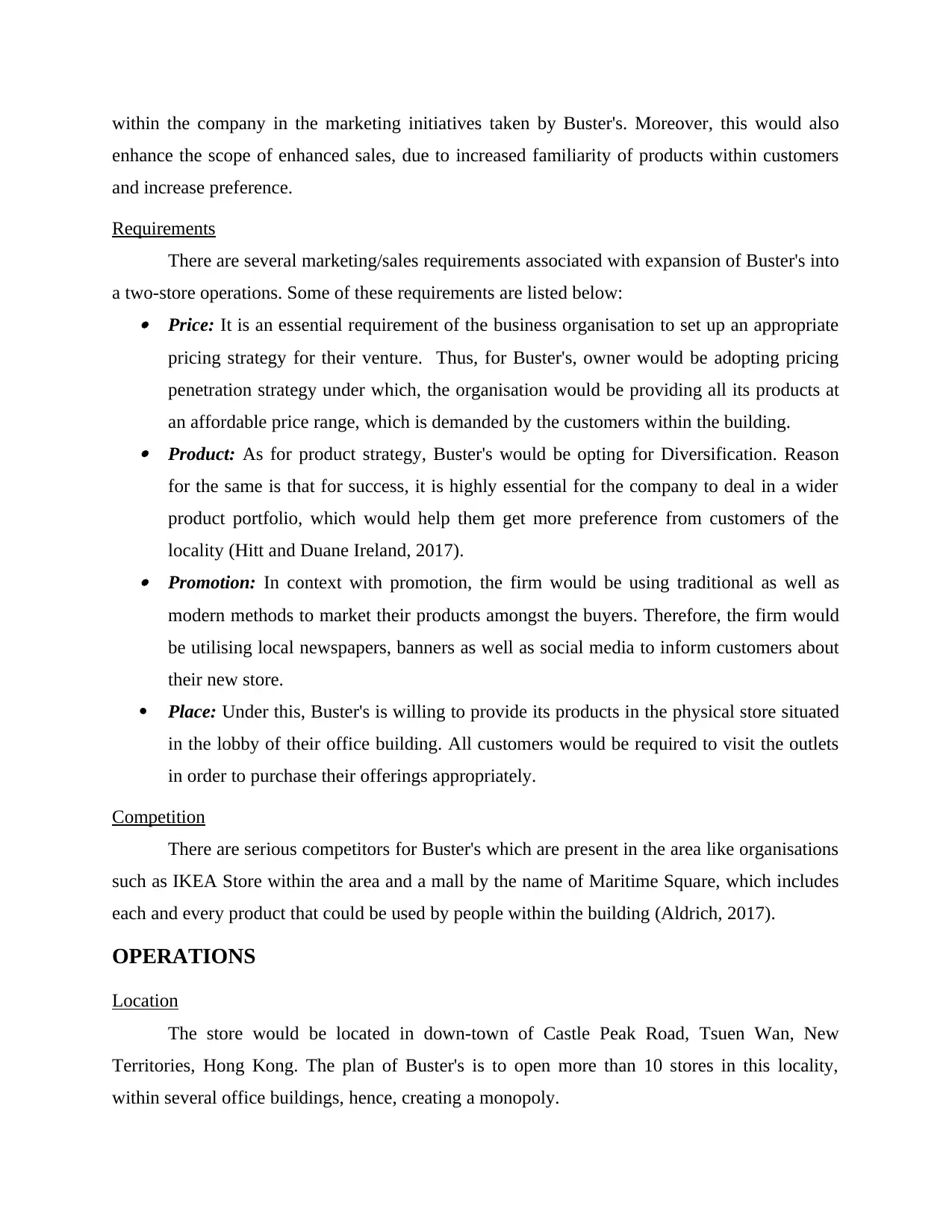
within the company in the marketing initiatives taken by Buster's. Moreover, this would also
enhance the scope of enhanced sales, due to increased familiarity of products within customers
and increase preference.
Requirements
There are several marketing/sales requirements associated with expansion of Buster's into
a two-store operations. Some of these requirements are listed below: Price: It is an essential requirement of the business organisation to set up an appropriate
pricing strategy for their venture. Thus, for Buster's, owner would be adopting pricing
penetration strategy under which, the organisation would be providing all its products at
an affordable price range, which is demanded by the customers within the building. Product: As for product strategy, Buster's would be opting for Diversification. Reason
for the same is that for success, it is highly essential for the company to deal in a wider
product portfolio, which would help them get more preference from customers of the
locality (Hitt and Duane Ireland, 2017). Promotion: In context with promotion, the firm would be using traditional as well as
modern methods to market their products amongst the buyers. Therefore, the firm would
be utilising local newspapers, banners as well as social media to inform customers about
their new store.
Place: Under this, Buster's is willing to provide its products in the physical store situated
in the lobby of their office building. All customers would be required to visit the outlets
in order to purchase their offerings appropriately.
Competition
There are serious competitors for Buster's which are present in the area like organisations
such as IKEA Store within the area and a mall by the name of Maritime Square, which includes
each and every product that could be used by people within the building (Aldrich, 2017).
OPERATIONS
Location
The store would be located in down-town of Castle Peak Road, Tsuen Wan, New
Territories, Hong Kong. The plan of Buster's is to open more than 10 stores in this locality,
within several office buildings, hence, creating a monopoly.
enhance the scope of enhanced sales, due to increased familiarity of products within customers
and increase preference.
Requirements
There are several marketing/sales requirements associated with expansion of Buster's into
a two-store operations. Some of these requirements are listed below: Price: It is an essential requirement of the business organisation to set up an appropriate
pricing strategy for their venture. Thus, for Buster's, owner would be adopting pricing
penetration strategy under which, the organisation would be providing all its products at
an affordable price range, which is demanded by the customers within the building. Product: As for product strategy, Buster's would be opting for Diversification. Reason
for the same is that for success, it is highly essential for the company to deal in a wider
product portfolio, which would help them get more preference from customers of the
locality (Hitt and Duane Ireland, 2017). Promotion: In context with promotion, the firm would be using traditional as well as
modern methods to market their products amongst the buyers. Therefore, the firm would
be utilising local newspapers, banners as well as social media to inform customers about
their new store.
Place: Under this, Buster's is willing to provide its products in the physical store situated
in the lobby of their office building. All customers would be required to visit the outlets
in order to purchase their offerings appropriately.
Competition
There are serious competitors for Buster's which are present in the area like organisations
such as IKEA Store within the area and a mall by the name of Maritime Square, which includes
each and every product that could be used by people within the building (Aldrich, 2017).
OPERATIONS
Location
The store would be located in down-town of Castle Peak Road, Tsuen Wan, New
Territories, Hong Kong. The plan of Buster's is to open more than 10 stores in this locality,
within several office buildings, hence, creating a monopoly.
Paraphrase This Document
Need a fresh take? Get an instant paraphrase of this document with our AI Paraphraser
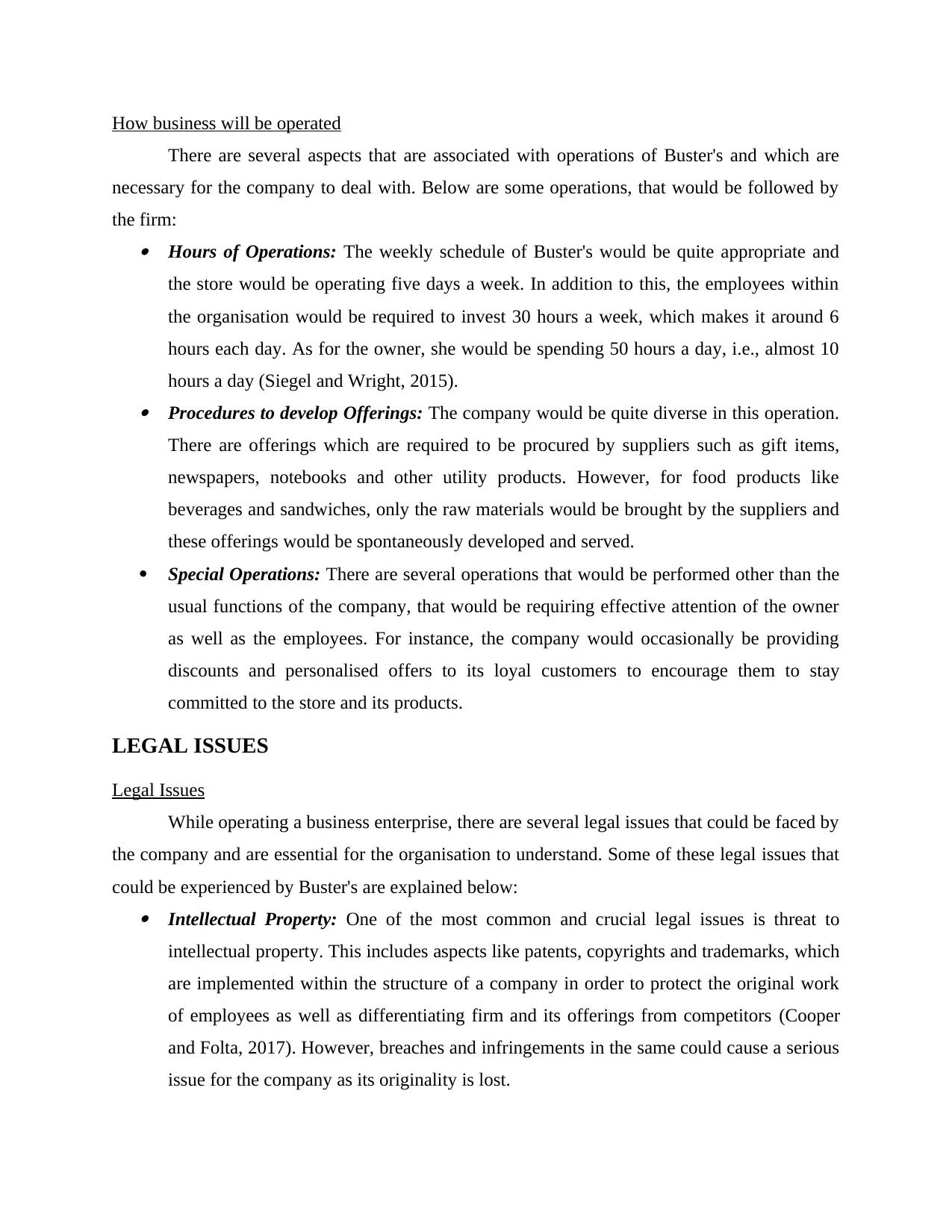
How business will be operated
There are several aspects that are associated with operations of Buster's and which are
necessary for the company to deal with. Below are some operations, that would be followed by
the firm: Hours of Operations: The weekly schedule of Buster's would be quite appropriate and
the store would be operating five days a week. In addition to this, the employees within
the organisation would be required to invest 30 hours a week, which makes it around 6
hours each day. As for the owner, she would be spending 50 hours a day, i.e., almost 10
hours a day (Siegel and Wright, 2015). Procedures to develop Offerings: The company would be quite diverse in this operation.
There are offerings which are required to be procured by suppliers such as gift items,
newspapers, notebooks and other utility products. However, for food products like
beverages and sandwiches, only the raw materials would be brought by the suppliers and
these offerings would be spontaneously developed and served.
Special Operations: There are several operations that would be performed other than the
usual functions of the company, that would be requiring effective attention of the owner
as well as the employees. For instance, the company would occasionally be providing
discounts and personalised offers to its loyal customers to encourage them to stay
committed to the store and its products.
LEGAL ISSUES
Legal Issues
While operating a business enterprise, there are several legal issues that could be faced by
the company and are essential for the organisation to understand. Some of these legal issues that
could be experienced by Buster's are explained below: Intellectual Property: One of the most common and crucial legal issues is threat to
intellectual property. This includes aspects like patents, copyrights and trademarks, which
are implemented within the structure of a company in order to protect the original work
of employees as well as differentiating firm and its offerings from competitors (Cooper
and Folta, 2017). However, breaches and infringements in the same could cause a serious
issue for the company as its originality is lost.
There are several aspects that are associated with operations of Buster's and which are
necessary for the company to deal with. Below are some operations, that would be followed by
the firm: Hours of Operations: The weekly schedule of Buster's would be quite appropriate and
the store would be operating five days a week. In addition to this, the employees within
the organisation would be required to invest 30 hours a week, which makes it around 6
hours each day. As for the owner, she would be spending 50 hours a day, i.e., almost 10
hours a day (Siegel and Wright, 2015). Procedures to develop Offerings: The company would be quite diverse in this operation.
There are offerings which are required to be procured by suppliers such as gift items,
newspapers, notebooks and other utility products. However, for food products like
beverages and sandwiches, only the raw materials would be brought by the suppliers and
these offerings would be spontaneously developed and served.
Special Operations: There are several operations that would be performed other than the
usual functions of the company, that would be requiring effective attention of the owner
as well as the employees. For instance, the company would occasionally be providing
discounts and personalised offers to its loyal customers to encourage them to stay
committed to the store and its products.
LEGAL ISSUES
Legal Issues
While operating a business enterprise, there are several legal issues that could be faced by
the company and are essential for the organisation to understand. Some of these legal issues that
could be experienced by Buster's are explained below: Intellectual Property: One of the most common and crucial legal issues is threat to
intellectual property. This includes aspects like patents, copyrights and trademarks, which
are implemented within the structure of a company in order to protect the original work
of employees as well as differentiating firm and its offerings from competitors (Cooper
and Folta, 2017). However, breaches and infringements in the same could cause a serious
issue for the company as its originality is lost.
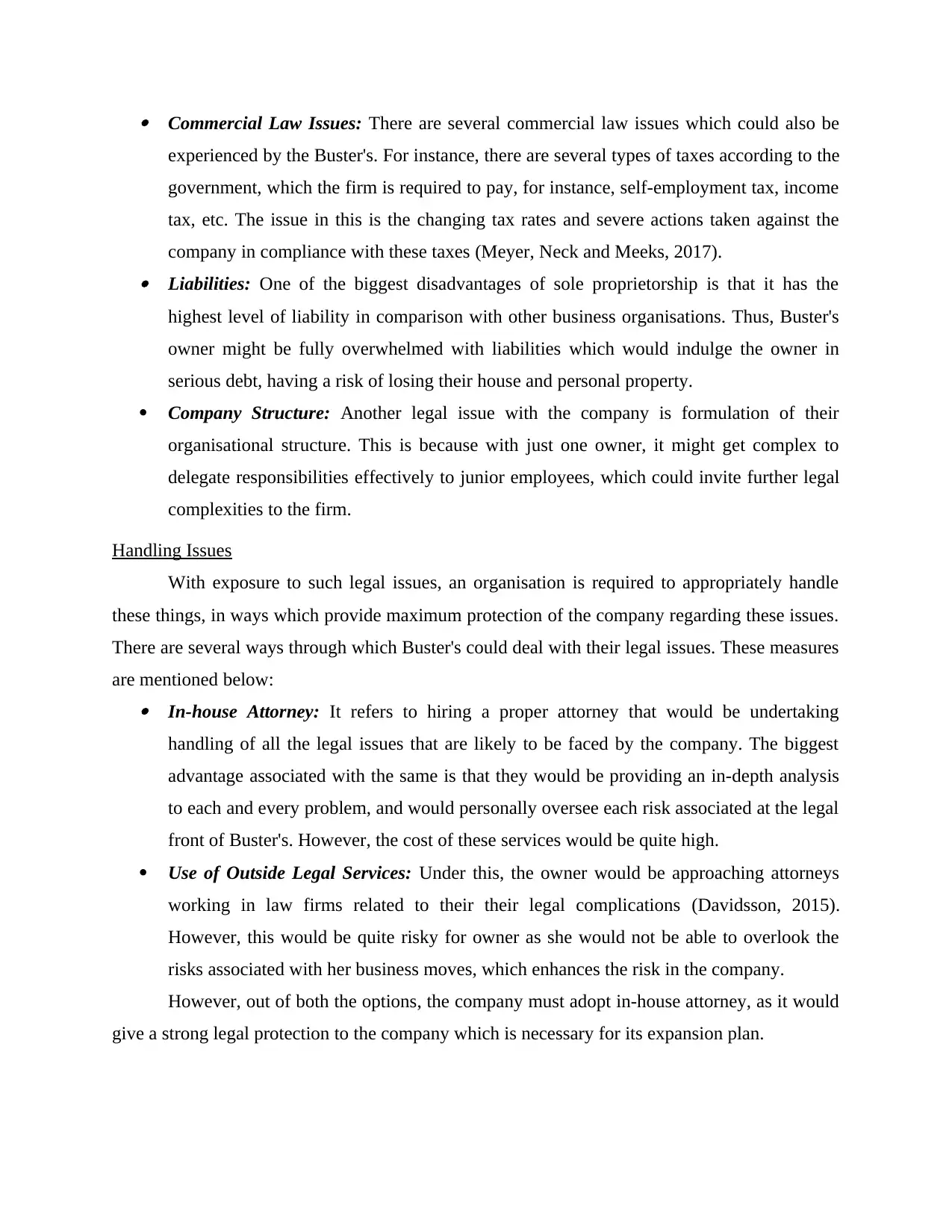
Commercial Law Issues: There are several commercial law issues which could also be
experienced by the Buster's. For instance, there are several types of taxes according to the
government, which the firm is required to pay, for instance, self-employment tax, income
tax, etc. The issue in this is the changing tax rates and severe actions taken against the
company in compliance with these taxes (Meyer, Neck and Meeks, 2017). Liabilities: One of the biggest disadvantages of sole proprietorship is that it has the
highest level of liability in comparison with other business organisations. Thus, Buster's
owner might be fully overwhelmed with liabilities which would indulge the owner in
serious debt, having a risk of losing their house and personal property.
Company Structure: Another legal issue with the company is formulation of their
organisational structure. This is because with just one owner, it might get complex to
delegate responsibilities effectively to junior employees, which could invite further legal
complexities to the firm.
Handling Issues
With exposure to such legal issues, an organisation is required to appropriately handle
these things, in ways which provide maximum protection of the company regarding these issues.
There are several ways through which Buster's could deal with their legal issues. These measures
are mentioned below: In-house Attorney: It refers to hiring a proper attorney that would be undertaking
handling of all the legal issues that are likely to be faced by the company. The biggest
advantage associated with the same is that they would be providing an in-depth analysis
to each and every problem, and would personally oversee each risk associated at the legal
front of Buster's. However, the cost of these services would be quite high.
Use of Outside Legal Services: Under this, the owner would be approaching attorneys
working in law firms related to their their legal complications (Davidsson, 2015).
However, this would be quite risky for owner as she would not be able to overlook the
risks associated with her business moves, which enhances the risk in the company.
However, out of both the options, the company must adopt in-house attorney, as it would
give a strong legal protection to the company which is necessary for its expansion plan.
experienced by the Buster's. For instance, there are several types of taxes according to the
government, which the firm is required to pay, for instance, self-employment tax, income
tax, etc. The issue in this is the changing tax rates and severe actions taken against the
company in compliance with these taxes (Meyer, Neck and Meeks, 2017). Liabilities: One of the biggest disadvantages of sole proprietorship is that it has the
highest level of liability in comparison with other business organisations. Thus, Buster's
owner might be fully overwhelmed with liabilities which would indulge the owner in
serious debt, having a risk of losing their house and personal property.
Company Structure: Another legal issue with the company is formulation of their
organisational structure. This is because with just one owner, it might get complex to
delegate responsibilities effectively to junior employees, which could invite further legal
complexities to the firm.
Handling Issues
With exposure to such legal issues, an organisation is required to appropriately handle
these things, in ways which provide maximum protection of the company regarding these issues.
There are several ways through which Buster's could deal with their legal issues. These measures
are mentioned below: In-house Attorney: It refers to hiring a proper attorney that would be undertaking
handling of all the legal issues that are likely to be faced by the company. The biggest
advantage associated with the same is that they would be providing an in-depth analysis
to each and every problem, and would personally oversee each risk associated at the legal
front of Buster's. However, the cost of these services would be quite high.
Use of Outside Legal Services: Under this, the owner would be approaching attorneys
working in law firms related to their their legal complications (Davidsson, 2015).
However, this would be quite risky for owner as she would not be able to overlook the
risks associated with her business moves, which enhances the risk in the company.
However, out of both the options, the company must adopt in-house attorney, as it would
give a strong legal protection to the company which is necessary for its expansion plan.
⊘ This is a preview!⊘
Do you want full access?
Subscribe today to unlock all pages.

Trusted by 1+ million students worldwide
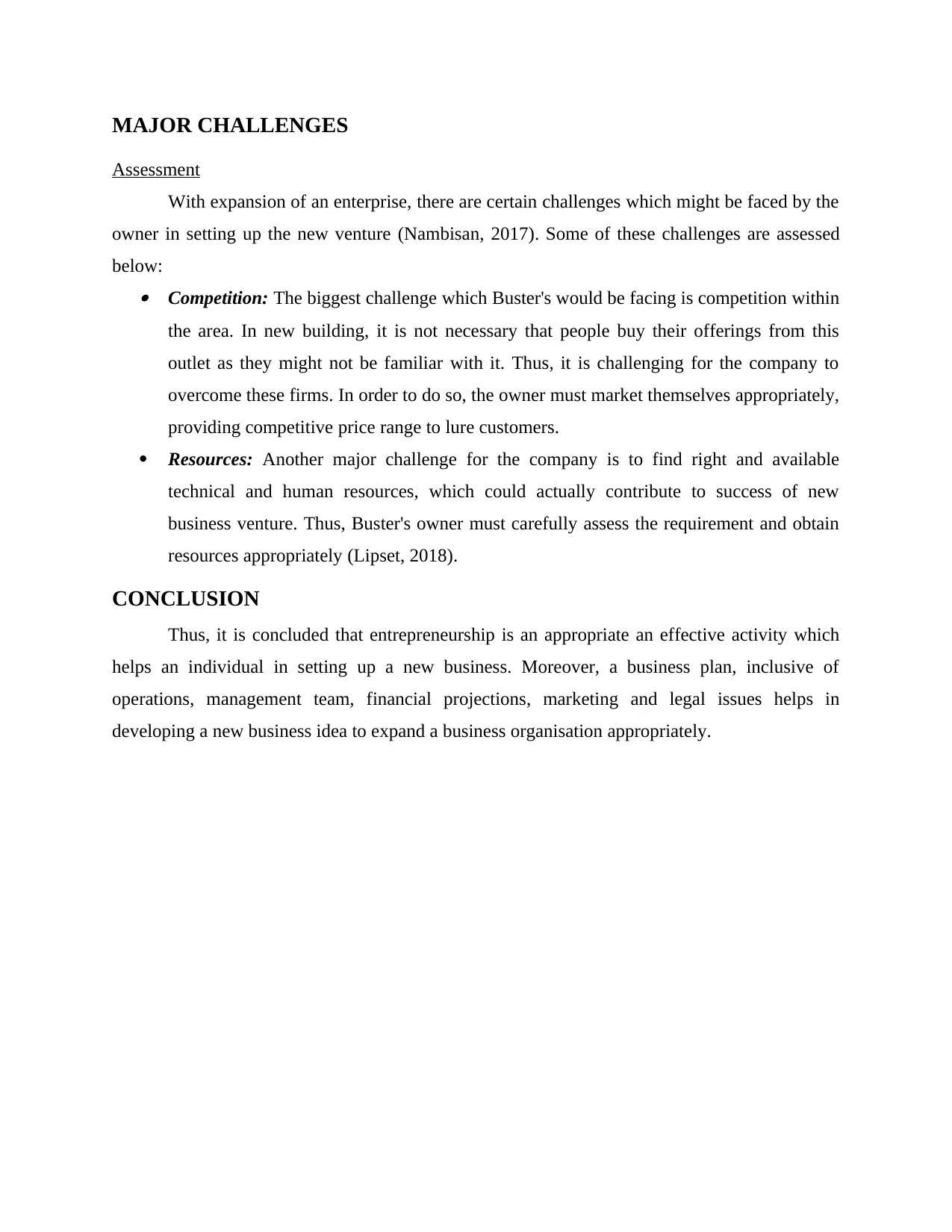
MAJOR CHALLENGES
Assessment
With expansion of an enterprise, there are certain challenges which might be faced by the
owner in setting up the new venture (Nambisan, 2017). Some of these challenges are assessed
below: Competition: The biggest challenge which Buster's would be facing is competition within
the area. In new building, it is not necessary that people buy their offerings from this
outlet as they might not be familiar with it. Thus, it is challenging for the company to
overcome these firms. In order to do so, the owner must market themselves appropriately,
providing competitive price range to lure customers.
Resources: Another major challenge for the company is to find right and available
technical and human resources, which could actually contribute to success of new
business venture. Thus, Buster's owner must carefully assess the requirement and obtain
resources appropriately (Lipset, 2018).
CONCLUSION
Thus, it is concluded that entrepreneurship is an appropriate an effective activity which
helps an individual in setting up a new business. Moreover, a business plan, inclusive of
operations, management team, financial projections, marketing and legal issues helps in
developing a new business idea to expand a business organisation appropriately.
Assessment
With expansion of an enterprise, there are certain challenges which might be faced by the
owner in setting up the new venture (Nambisan, 2017). Some of these challenges are assessed
below: Competition: The biggest challenge which Buster's would be facing is competition within
the area. In new building, it is not necessary that people buy their offerings from this
outlet as they might not be familiar with it. Thus, it is challenging for the company to
overcome these firms. In order to do so, the owner must market themselves appropriately,
providing competitive price range to lure customers.
Resources: Another major challenge for the company is to find right and available
technical and human resources, which could actually contribute to success of new
business venture. Thus, Buster's owner must carefully assess the requirement and obtain
resources appropriately (Lipset, 2018).
CONCLUSION
Thus, it is concluded that entrepreneurship is an appropriate an effective activity which
helps an individual in setting up a new business. Moreover, a business plan, inclusive of
operations, management team, financial projections, marketing and legal issues helps in
developing a new business idea to expand a business organisation appropriately.
Paraphrase This Document
Need a fresh take? Get an instant paraphrase of this document with our AI Paraphraser
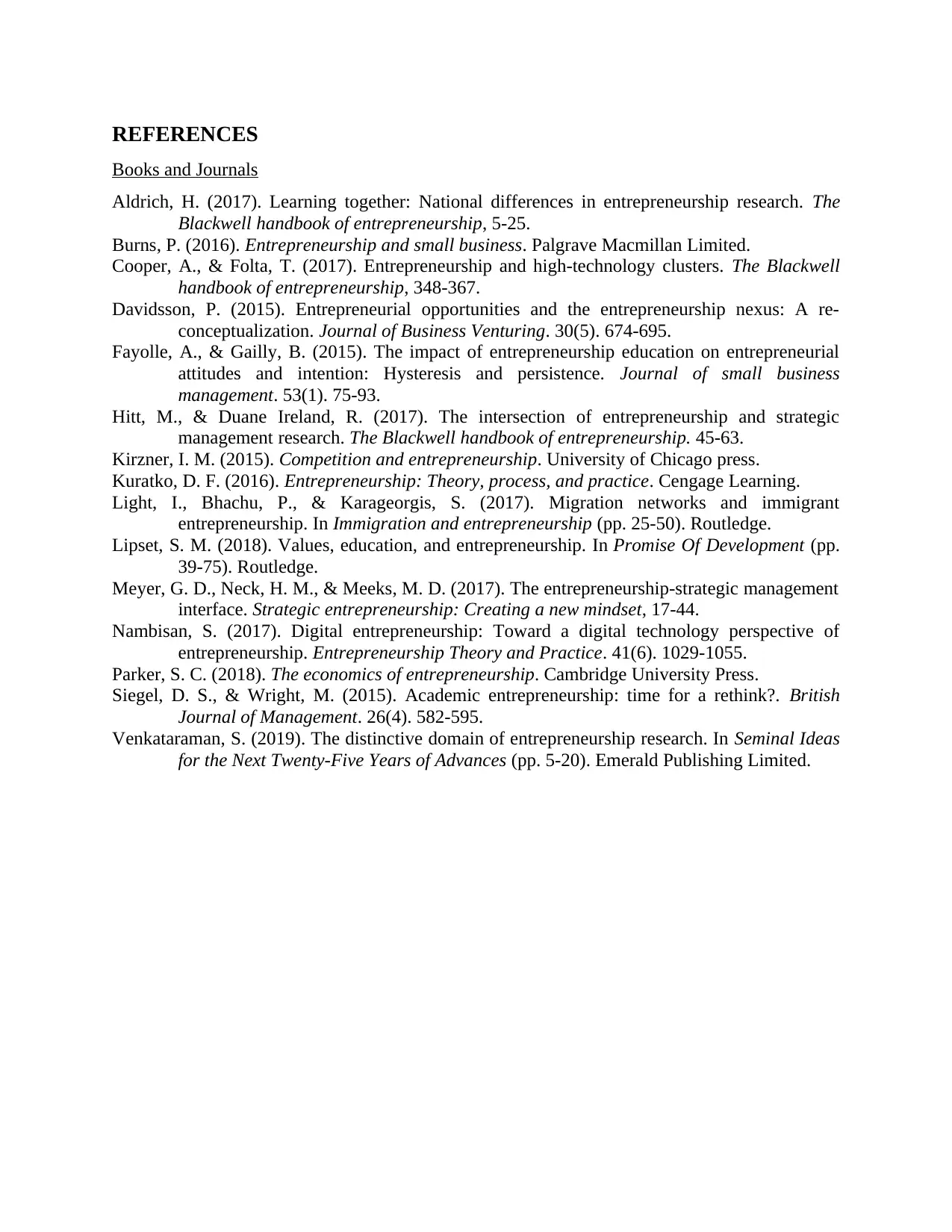
REFERENCES
Books and Journals
Aldrich, H. (2017). Learning together: National differences in entrepreneurship research. The
Blackwell handbook of entrepreneurship, 5-25.
Burns, P. (2016). Entrepreneurship and small business. Palgrave Macmillan Limited.
Cooper, A., & Folta, T. (2017). Entrepreneurship and high‐technology clusters. The Blackwell
handbook of entrepreneurship, 348-367.
Davidsson, P. (2015). Entrepreneurial opportunities and the entrepreneurship nexus: A re-
conceptualization. Journal of Business Venturing. 30(5). 674-695.
Fayolle, A., & Gailly, B. (2015). The impact of entrepreneurship education on entrepreneurial
attitudes and intention: Hysteresis and persistence. Journal of small business
management. 53(1). 75-93.
Hitt, M., & Duane Ireland, R. (2017). The intersection of entrepreneurship and strategic
management research. The Blackwell handbook of entrepreneurship. 45-63.
Kirzner, I. M. (2015). Competition and entrepreneurship. University of Chicago press.
Kuratko, D. F. (2016). Entrepreneurship: Theory, process, and practice. Cengage Learning.
Light, I., Bhachu, P., & Karageorgis, S. (2017). Migration networks and immigrant
entrepreneurship. In Immigration and entrepreneurship (pp. 25-50). Routledge.
Lipset, S. M. (2018). Values, education, and entrepreneurship. In Promise Of Development (pp.
39-75). Routledge.
Meyer, G. D., Neck, H. M., & Meeks, M. D. (2017). The entrepreneurship‐strategic management
interface. Strategic entrepreneurship: Creating a new mindset, 17-44.
Nambisan, S. (2017). Digital entrepreneurship: Toward a digital technology perspective of
entrepreneurship. Entrepreneurship Theory and Practice. 41(6). 1029-1055.
Parker, S. C. (2018). The economics of entrepreneurship. Cambridge University Press.
Siegel, D. S., & Wright, M. (2015). Academic entrepreneurship: time for a rethink?. British
Journal of Management. 26(4). 582-595.
Venkataraman, S. (2019). The distinctive domain of entrepreneurship research. In Seminal Ideas
for the Next Twenty-Five Years of Advances (pp. 5-20). Emerald Publishing Limited.
Books and Journals
Aldrich, H. (2017). Learning together: National differences in entrepreneurship research. The
Blackwell handbook of entrepreneurship, 5-25.
Burns, P. (2016). Entrepreneurship and small business. Palgrave Macmillan Limited.
Cooper, A., & Folta, T. (2017). Entrepreneurship and high‐technology clusters. The Blackwell
handbook of entrepreneurship, 348-367.
Davidsson, P. (2015). Entrepreneurial opportunities and the entrepreneurship nexus: A re-
conceptualization. Journal of Business Venturing. 30(5). 674-695.
Fayolle, A., & Gailly, B. (2015). The impact of entrepreneurship education on entrepreneurial
attitudes and intention: Hysteresis and persistence. Journal of small business
management. 53(1). 75-93.
Hitt, M., & Duane Ireland, R. (2017). The intersection of entrepreneurship and strategic
management research. The Blackwell handbook of entrepreneurship. 45-63.
Kirzner, I. M. (2015). Competition and entrepreneurship. University of Chicago press.
Kuratko, D. F. (2016). Entrepreneurship: Theory, process, and practice. Cengage Learning.
Light, I., Bhachu, P., & Karageorgis, S. (2017). Migration networks and immigrant
entrepreneurship. In Immigration and entrepreneurship (pp. 25-50). Routledge.
Lipset, S. M. (2018). Values, education, and entrepreneurship. In Promise Of Development (pp.
39-75). Routledge.
Meyer, G. D., Neck, H. M., & Meeks, M. D. (2017). The entrepreneurship‐strategic management
interface. Strategic entrepreneurship: Creating a new mindset, 17-44.
Nambisan, S. (2017). Digital entrepreneurship: Toward a digital technology perspective of
entrepreneurship. Entrepreneurship Theory and Practice. 41(6). 1029-1055.
Parker, S. C. (2018). The economics of entrepreneurship. Cambridge University Press.
Siegel, D. S., & Wright, M. (2015). Academic entrepreneurship: time for a rethink?. British
Journal of Management. 26(4). 582-595.
Venkataraman, S. (2019). The distinctive domain of entrepreneurship research. In Seminal Ideas
for the Next Twenty-Five Years of Advances (pp. 5-20). Emerald Publishing Limited.
1 out of 11
Related Documents
Your All-in-One AI-Powered Toolkit for Academic Success.
+13062052269
info@desklib.com
Available 24*7 on WhatsApp / Email
![[object Object]](/_next/static/media/star-bottom.7253800d.svg)
Unlock your academic potential
Copyright © 2020–2025 A2Z Services. All Rights Reserved. Developed and managed by ZUCOL.




